
There has always been an age-old issue of conflicts between humans and wildlife; us against them. In the past, we got rid of the “problem” swiftly but with little thought as to the long term consequences. Now, we have expanded and concentrated our population to the point that we are noticing the impacts. We have realized that resources are finite and we have to take into consideration the other surviving inhabitants around us who also rely on the same resources.
As human populations increase and encroach, conflict situations will become more frequent. The “problem” is not going to go away. We might as well try to deal with the issue before it becomes a full-blown crisis. We can’t just do our own thing and let Nature do its own thing, so inevitably we have to manage Nature and ourselves. And if we are really part of Nature, then we have to have integration that reflects that, i.e., some compromise on our part.
As I mentioned in my previous post, we need to accommodate wildlife back into our lives. We have an obligation to leave corridors open for passage, whether flywaysfor migratory birds or ravines for short haul operators; for terrestrial, aquatic (rivers carve ravines), and short flight movements. We have to supplement public green space, some of which is tame, human playgrounds, by establishing and maintaining wildlife habitat on private property – front, side and backyards. This patchwork of yards could be stitched together to provide a mosaic of habitat which is particularly crucial in areas that lack ravines or other areas that could not be built upon by us and have been left for the most part, to their own devices.
However, in the cities, many plants and animals have already left. They were the specialists which could not compromise. Specialists may still visit; wander or fly through with short stopovers – the accidental tourists. If by chance they stay, it’s not for long and they move on or die. A rare few will make do with a small, precarious niche. So, we are left with generalists that not only have adapted to our ways of city life but have even flourished.
Here comes the tricky part: we can’t pick and choose which wildlife will take an opportunity to enjoy our properties. It would be ideal to have well-behaved wildlife set up home. But for the most part, we will have the generalists which will take advantage of every opportunity that we afford them. So, it is crucial that we not habituate wildlife to us by enabling them to the point of becoming nuisances (e.g., begging at the back door for scraps). It can be a fine line between enjoying the presence of wildlife and being driven to desperate measures that don’t turn out well for anyone.
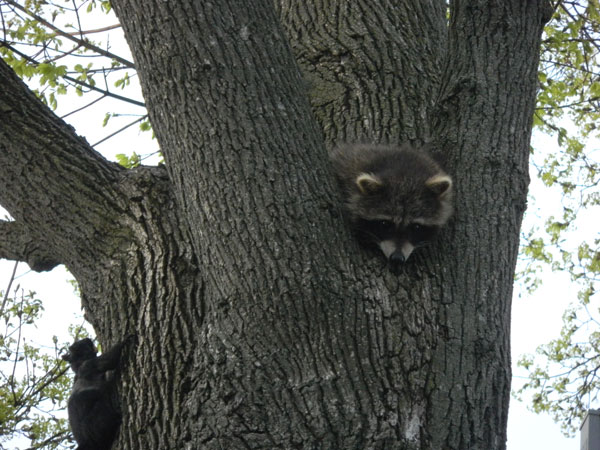
Typically, much of the human-wildlife conflict occurs at the edges. In cities, the smaller fauna can infiltrate with relative ease and go undetected. In particular, some fauna is so adept at living with us, so in essence, there is no edge when it comes to certain generalists (raccoons) and a few other opportunistic wildlife, as well as vermin, of course. Even if you took away green infrastructure – trees, soil, and paved the whole thing over, they would still be there, finding refuge in a garage or shed, dining on roadkill, and picking through a knocked over garbage can or bowl of cat food left outdoors.
Infrastructure for Wildlife
Being in the tight confines of the city has its special considerations, though any human habitation and activities will have bearing whether in sprawling suburbs, smaller towns, or rural settings. The basic infrastructure is present: both gray (buildings, roads, utilities) and green (trees, shrubs, groundcover). The ratio will differ where gray infrastructure is greater and green is less in cities.
There are advantages and disadvantages to gray infrastructure. Railway lines, roads, sidewalks and pathways are all used by wildlife to traverse the city. But collisions with vehicles can be deadly. However, scavengers can take advantage of road or rail kill.
Tall buildings with ledges are used for perches or nesting sites for raptors, e.g., Peregrine Falcon. But they can also attract migrating birds which may collide into reflective glass with lethal results ( but more scavenging opportunities).
Green roofs can host plants and some wildlife, but access is limited by issues to do with the building height.
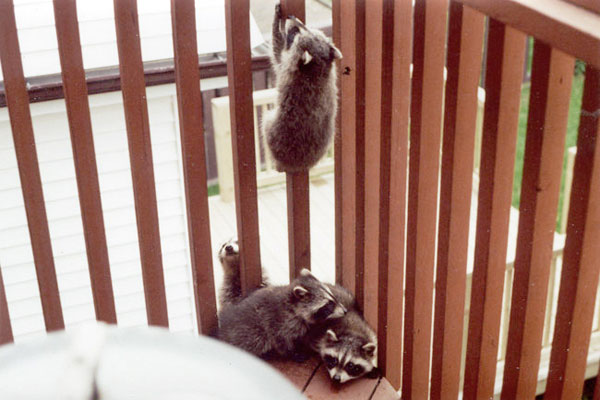
I used to think hydro poles and wires were a blight on the landscape and should be buried as they do in some areas, until I observed tree squirrels using them as a substitute for trees. When swathes of forests covered the landscape, squirrels could run through the trees and only come down to the ground to bury acorns. With the lack of contiguous canopy cover in cities, squirrels are more exposed to danger when they have to traverse ground to reach the next tree. The lines that run from the major feed to houses are highways for squirrels and perches for birds. However, some risk is introduced when squirrels inadvertently touch different levels of high voltage lines at the same time. I’ve actually witnessed a squirrel get electrocuted and drop to the ground dead.
Fewer trees in the city means reduced housing for various organisms from fungi, to insects to cavity-nesting critters. For health and safety reasons, we cannot keep dead snags. The liability factor precludes having dead trees because they have a higher risk of toppling. Besides, they don’t perform the same duties as living trees which are more valuable in the city when combating heat island effect through shade, producing oxygen, taking up carbon dioxide, and mitigating pollution. If native, they are food producers for folivores. When space is at a premium, a dead tree would take up a spot needed for a live replacement, even though both could provide shelter. Some live trees may have holes for cavity-dwellers, but typically they are hard to come by. In absence of snags, adaptive wildlife, like the eastern gray squirrel will live in large leaf nests or drays. They are not as weatherproof, so it is paramount that you secure your nice, dry attic or garage from opportunistic interlopers.
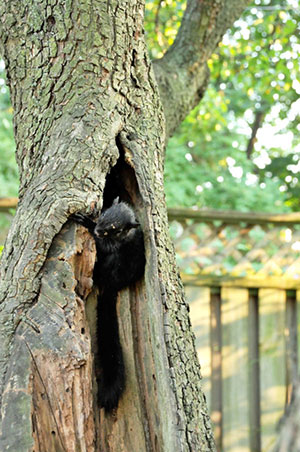
“No wild species evolved to live in cities”
Wildlife has adapted to take advantage of city living and in doing so wildlife is re-writing the books on behaviour. For example, some of the smaller carnivores, fox and coyote are dawn & dusk (crepuscular) in nature but are quickly adapting to urban life. Many are adjusting their schedules and becoming more nocturnal to avoid human presence, while others may become accustomed to us and look for hand outs based on a human schedule. They know where the food is and how to get it.
Due to the ready availability of large quantities of food, wildlife populations may increase to artificial levels. Population increases will lead to more encounters because of the higher density of animals. Density pressure may change not only the population dynamics, but the animals themselves. A study on red squirrels indicates evidence that under stress they produce larger young faster. The trade off is they could defend a territory and survive to breed, but at a cost of a shorter life.
We may actually be “educating” some wildlife to the point where they are getting smarter. Dr. Suzuki’s Nature of Things TV program: Raccoon Nation illustrates how well raccoons have adapted and thrived in cities and they are learning novel ways to procure food and shelter. So we will have to be constantly vigilant to out-smart our crafty critters.

The most lethal predator is human. The vehicle is the means for dispatching humans, pets, and wildlife. All are potential collateral damage in our need for transportation. We can build highway underpasses and overpasses for wildlife in areas with large populations of wildlife moving about. It is not a reasonable expectation within the core areas of the city where road infrastructure consists of a network of intersecting streets. With the sheer number of roads, we cannot use widespread remedies. Some collisions with wildlife are not preventable, but on residential streets with much lower speed limits, we would assume drivers would take more care.

In a previous post about wildlife and vermin, I noted that it was difficult to distinguish between the two terms, as we are typically loose with definitions. Typically, “vermin” is a term for nuisance animals used at the municipal level in bylaws. While skunks, squirrels and raccoons, may be nuisances, they are not vermin. They are “wildlife” designated under fish and wildlife acts enacted to manage game or furbearers to ensure sustainable populations. The acts supersede any authority at the municipal level. Therein lies some of the angst when the problem is at a municipal level and the nuisance animals are protected at a state or provincial level. It’s perfectly reasonable to have this arrangement as wildlife does not have a notion of arbitrary human boundaries. Wildlife moves around or migrates at will. Migratory birds are covered under federal acts; mammals are typically a provincial or state responsibility. That is why municipalities can feel helpless, and have their hands tied. However, usually provisions can be made to deal with nuisance or dangerous wildlife.
In my case, I am governed by the Fish and Wildlife Conservation Act, 1997 (Provincial Act) S.O. 1997, CHAPTER 41.
Basically under the Act, a person or their agent can only harass, but not capture or kill the offending wildlife without authorization, and not cause unnecessary suffering (Section 31). Under municipal law, no hunting or trapping is allowed with city limits without permission. Those who contravene the laws are dealt with…and sometimes not too swiftly in the case of one homeowner. He pled guilty to beating three baby raccoons with a shovel, probably killing one (the mother raccoon ran off with it) and breaking another’s foreleg, because they were destroying his garden in 2011. After 19 court appearances, the case was finally settled and he was sentenced to pay $1,365 restitution for vet care and to do 100 volunteer hours at a humane society shelter.
Wildlife can be removed from a dwelling. If it is to be relocated, it must be moved by a licensed authorized agent and released not more than 1 km (0.6 miles) from where it was captured. If an animal is taken far from its territory and is dumped in an unfamiliar place, it will probably die because it will not have knowledge of food resources, shelter and competitors. Rural residents don’t need you to dump on them, too. As it is, they deal with unwanted pets abandoned by irresponsible pet owners.
Megafauna such as bears could be dangerous in a city environment. Indeed, last year a black bear wandered into a city just north of Toronto. Efforts to capture and relocate were unsuccessful and resulted in the bear being shot by police. Wildlife services and occasionally, the local zoo have been called in to help, but sometimes the issue is urgent enough that the police have to make a judgement call to protect the public. Police have been criticized for making hasty decisions. Given that the police are called into a situation without knowledge of wildlife, they can’t be blamed for erring on the side of caution.
We don’t normally have megafauna reach the centre of Toronto, but three and a half years ago, we had a white-tailed deer loose in a garden. It was tasered (by police) and tranquilized (by zoo staff) before being successfully moved to one of our wild spaces on the lakefront.
Urban Canada Geese have been a problem as they do not migrate and like our expansive lawns, particularly on corporate or public lands. In many areas, wildlife managers have resorted to coating eggs with vegetable oil so that air exchange does not occur and embryos die. Some agencies round up geese and truck them away from cities; however, they can suffocate if not handled properly. Besides, if they were shipped out as adult birds, they may find their way back.
Raccoons are the perfect animals for cities. While foxes and coyotes live on the edges of cities raccoons are extremely flexible to take advantage of novel environments because of their great hands. We must learn to live with them. The goal should be to reduce conflict, so don’t beat them with shovels. (Dr. Suzanne MacDonald, Comparative Psychologist,York University)
Facts About Raccoons (source: CBC Nature of Things)
Raccoon have been around for 40,000 years and originated in the tropics where they foraged for food along riverbanks.
- Raccoons migrated north by adapting to new environments and are now found as far north as Alaska.
- Raccoons are small, have sensitive hands and can eat just about anything, making them ideal for urban life.
- Urban raccoon populations have grown 20 fold in the last 70 years.
- Toronto is the raccoon capital of the world. Fifty times more raccoons live in the city than in the surrounding countryside.
- Raccoons’ hands have a dense mesh of nerves that act almost like taste buds sending information to the brain.
- Raccoons use up to 20 den sites at a time, from sheds to sewers.
- Their only real predator in urban environments is cars, which are the number one cause of raccoon mortality in cities.
- In the city, raccoon territories average around three square blocks. They prefer backyards to parks.
In my city of Toronto of almost 2.8 million people, it is estimated that there are 100,000 raccoons. That’s a lot of fur flying when homeowners get exasperated dealing with the problems associated with raccoons: upturned-waste containers, dug up lawns, raccoon feces, intruders in the attic or shed. These urban raccoons are bold, not like their shy country cousins.
So as urban dwellers we have our work cut out for us. We don’t have to resort to violence. If we are supposedly the smarter species, let’s step up and figure out how we are going to live together in harmony.
STOP FEEDING WILDLIFE!
Did I get your attention? That is the solution, but it is not easy. We feed wildlife through direct or indirect feeding. We could stop direct feeding by banning feeding, but enforcement will not ensure complete compliance. It’s a community effort. Certainly we can start in public places by discouraging the feeding of feeding pigeons, ducks, geese and other wildlife.
Private bird feeders could be seen as direct or indirect feeding sources. Feeders attract a host of non-targeted wildlife including squirrels, raccoons, and sometimes bears. We’ve built an entire industry around bird feeders, so I’m not sure if even limiting the number of feeders would work. Planting native plants will encourage natural foraging by birds and reduce the reliance on feeders.
The major problem is the feeding of raccoons and other carnivores, directly. Animals with the flexibility to live among us in the city will readily habituate to hand outs and become nuisances.
Waste Management
Wildlife; most notably, raccoons, skunks, squirrels, birds don’t tear through bags anymore since we went to the bin system for waste management. Recyclables must be rinsed to avoid odours that attract wildlife. In my experience, I have not seen a recycle or garbage bin knocked over by wildlife.
The green bin is another matter. This is a case of indirect feeding. We’ve concentrated organic waste in one, big takeout container. And take it out, they will. Our green bins were field tested, supposedly. But raccoons have adapted to this contrivances since their introduction several years ago. The latch is no match for a raccoon when they will just knock the whole issue over. To help stop the plundering of organic waste, consider a few tips on green bin etiquette:
- put the bin out in the morning, if possible, stop the nocturnal foragers
- latch the bin shut and reinforce with a bungee cord if leaving the bin overnight, but remove the bungee cord in the morning (then why not just put the bin out in the morning?)
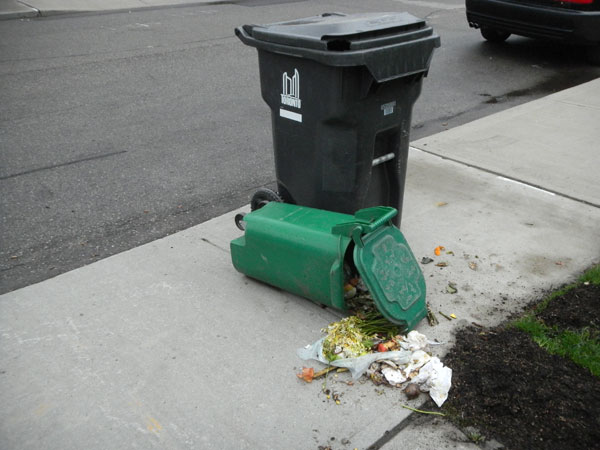
Waste management also includes dealing with waste from wildlife. Even though pet feces can be collected in the green bin, do not put raccoon feces in any bin or composter.
The handling of raccoon feces should be dealt with very carefully as up to 80% of raccoons carry the parasite, raccoon roundworm (Baylisascaris procyonis). As with the majority of parasites which are host-specific, things can go wrong if an organism is not the intended host. Raccoons are the primary host of the nematode worm and are not killed by the adult worms which live in the raccoon’s intestine. However, a variety of other small mammals, including squirrels, groundhogs and rabbits, can be fatally infected. The unintended host, e.g., squirrel gets infected with roundworm when it digs through the scat of an infected raccoon, looking for seeds to eat, and unwittingly ingests roundworm eggs that have been excreted in the feces. Larvae can migrate into the bloodstream and find their way into the eyes or brain, causing severe disease or death. Humans, particularly children, are occasionally infected.
I’ve seen several cases of squirrels infected. They are easy to spot with their loss of balance, to the point of continual circling when they are near death.
So treat raccoon feces seriously. If you find raccoon excrement or a communal “latrine,” around your property, consider calling in a professional wildlife service for decontamination. If you opt to do the cleanup yourself, wildlife centres advise that you do so cautiously. Wear a protective mask, gloves and clothing that can be discarded after use. Burn the feces or put it in garbage that will be buried in a landfill. Under no circumstances should feces be deposited in an area in which there is likely to be human or animal contact, including composters. Roundworm eggs will survive freezing or the heat produced in composting, including professional facilities which produce higher heat.
Composters
Any city garbage collector will tell you that we have more mice and rats because of the use of composters. The real culprit is not maintaining it. If you are noticing activity of rodents, then line the bin next time you empty it. Here I used ¼” hardware screen which solved the problem and still allowed decomposers access. Make sure you cover additions with leaves and moisten it. Layer as normal with green (nitrogen, e.g., fruit, vegetable waste, grass clippings) and brown (carbon-rich, e.g., leaves). Don’t include meat, bones, dairy which can be saved for green bin pickup (if available in your area). Some people freeze their organics before adding which makes it less appealing to scavengers. A large stone on top of the lid discourages raccoon visitors looking for worms and other invertebrates.
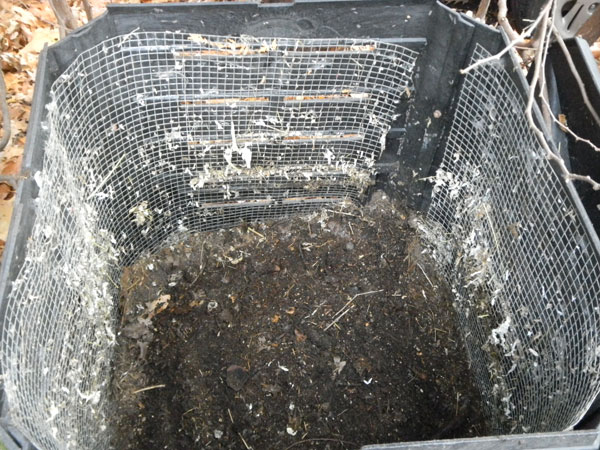
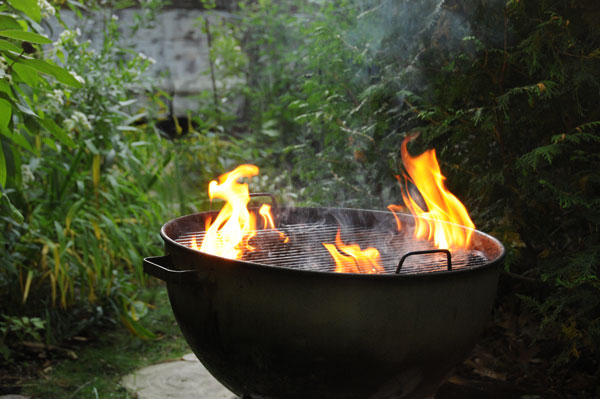
Cooking on a barbeque can entice unwanted guests. While cooking, never leave the bbq unattended (unless for a short time with the lid closed). Remember to close the lid when finished and remove any traces of food (grease pan, utensils). We had a skunk trot through the yard, probably enticed by the smells of the barbequed salmon. Raccoons start stirring for their nocturnal forays too and may also be attracted. It’s best not to barbeque at dusk if you have a lot of wildlife with a taste for barbequed food.
At a minimum, a weekly check should be part of your routine as you putter about. Don’t blame wildlife or vermin for faults in structures, they just report them by finding any breach of your dwelling and infiltrating if given the opportunity. Think of wildlife and vermin as free home inspectors. So do regular checks. Don’t forget window wells. Wildlife can get trapped. Fledgling birds can be lifted out and released. Depending on the depth and materials of the window well, even climbers may not be able to escape, e.g., mice. Leave a long stick to encourage the animal to climb out or a plank to walk (in case of a skunk). It’s better to secure the window well with hardware screen or a cover.
Every spring we get articles appearing in the local papers about nuisance animals wrecking havoc with properties. The latest was a woman complaining about raccoons tearing apart her chimney, when it was evident that the dwelling was old and maybe the upkeep of the chimney was neglected to the point of imminent collapse.
Toronto Animal Services supervisor Fiona Venedam said residents can reduce conflict by employing a number of useful tricks: Secure your garbage, cut tree branches that overhang homes, cover access holes to garages or attics, cover grape vines with wire mesh, maybe even sprinkle some oil of mustard around your property to deter them.
Squirrels notice disturbed soil (visually or by scent of freshly exposed soil to the surface). Covering the soil around plants with leaves might help so they don’t tend to dig as much. I’ve had success with rocks around plants but one squirrel in my yard had a habit of pulling plants out between the rocks and plopping them on the ground beside the hole. He knew where every new plant had been put in and had to pull every one of them out. So, sometimes you have to go all out and use hardware screen on the ground around the entire plant to stop the activity.
Lawn digging
Get rid of the lawn – – get rid of the problem. Ah, but you want some lawn. Well, you will get white grubs (beetle larvae) that are coveted by skunks and raccoons. Raccoons love to roll sod, so pinning down the corners of new sod helps to deter this activity until the roots take hold. Screen and pins also work well if you reseed an area and you want to discourage digging.
Keep reading NPWG posts to get more comfortable with lawn-less gardens.
We have to realize that wild animals are not pets. Don’t expect wild animals to perform, act or react as domestic pets which have trained you in the ways of animals. Wildlife is not intentionally trying to annoy you; though sometimes, I suspect certain critters secretly plot. A neighbour was at war with the local raccoon that would use his backyard pergola as a raccoon latrine. The neighbour was beside himself and used all kinds of barriers, including illegal methods (barbed wire and electrical fencing/hot wire) to no avail. The raccoon was able to skirt the defences and carry on. Meanwhile, my friend who lived next door also had a backyard pergola, with no defence system in place and did not incur any damage.
Our wildlife centres call for more public education through prevention and by maintaining healthy relationships with predators, i.e., coyotes.
Toronto Wildlife Centre executive director Nathalie Karvonen says the ban on feeding coyotes is the key. “If you don’t feed them, they’ll just quietly go about their business and they will ignore people, which is what most coyotes are doing in Toronto.” Ravine territory should be kept buffered and as intact as possible for hunting natural food sources. Garbage and dog food and other food items that may attract coyotes should be kept out of backyards and stored safely in the garage.
This is good advice when dealing with any wildlife.
A quick note about wildlife and rabies
Rabies is always a possibility when dealing with mammals. Ontario has almost eliminated the virus in raccoons, foxes and skunks through an ongoing program of aerial vaccine baiting. However, the bait is not taken by bats. And animals can shed virus for several days before they can show symptoms.
“If it’s not your animal, leave it alone. This is more than avoiding diseased animals. Enjoy wildlife from a distance.” Adam McAllister of the Ontario Ministry of Natural Resources.
Local help in Toronto area: Toronto Wildlife Centre (TWC) is a charitable organization and a leader in the field of wildlife rescue, veterinary care, rehabilitation and education for 20 years.
Book: Nature Wars – Jim Sterba (2012)
Thanks to a reader (Russ) for the tip. The whole issue is put in a historical North American context. Much of it is common sense. The major problem is our attitude towards wildlife, our notions, and what we expect from wildlife. One minor quibble: I have issue with those who use the phrase “birds and animals” instead of “birds and mammals” which Sterba uses at least twice. One of my professors was very critical of this faux pas in science writing.
Programs: The Nature of Things with David Suzuki has two episodes of interest. Highly informative and entertaining:
Raccoon Nation (plus more interviews and tips)
Originally published May 26, 2013 on Native Plants and Wildlife Gardens
